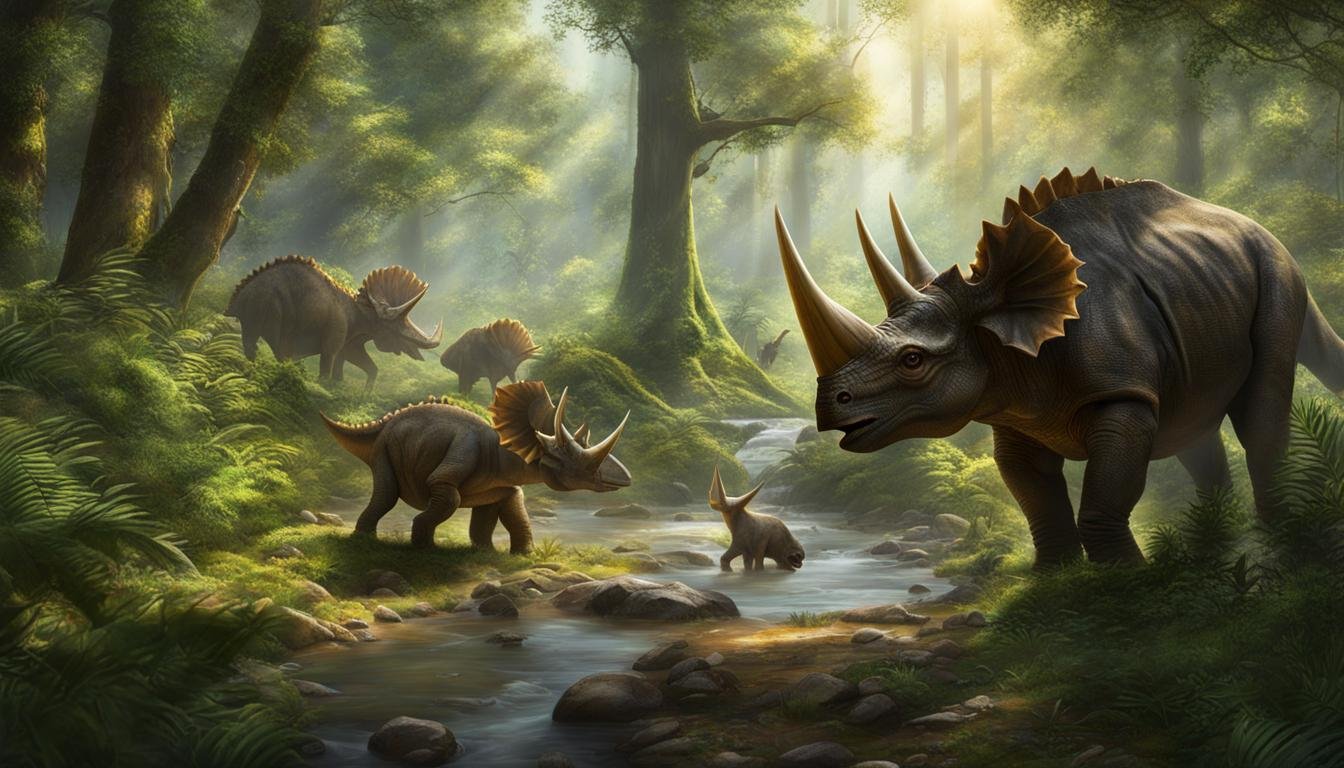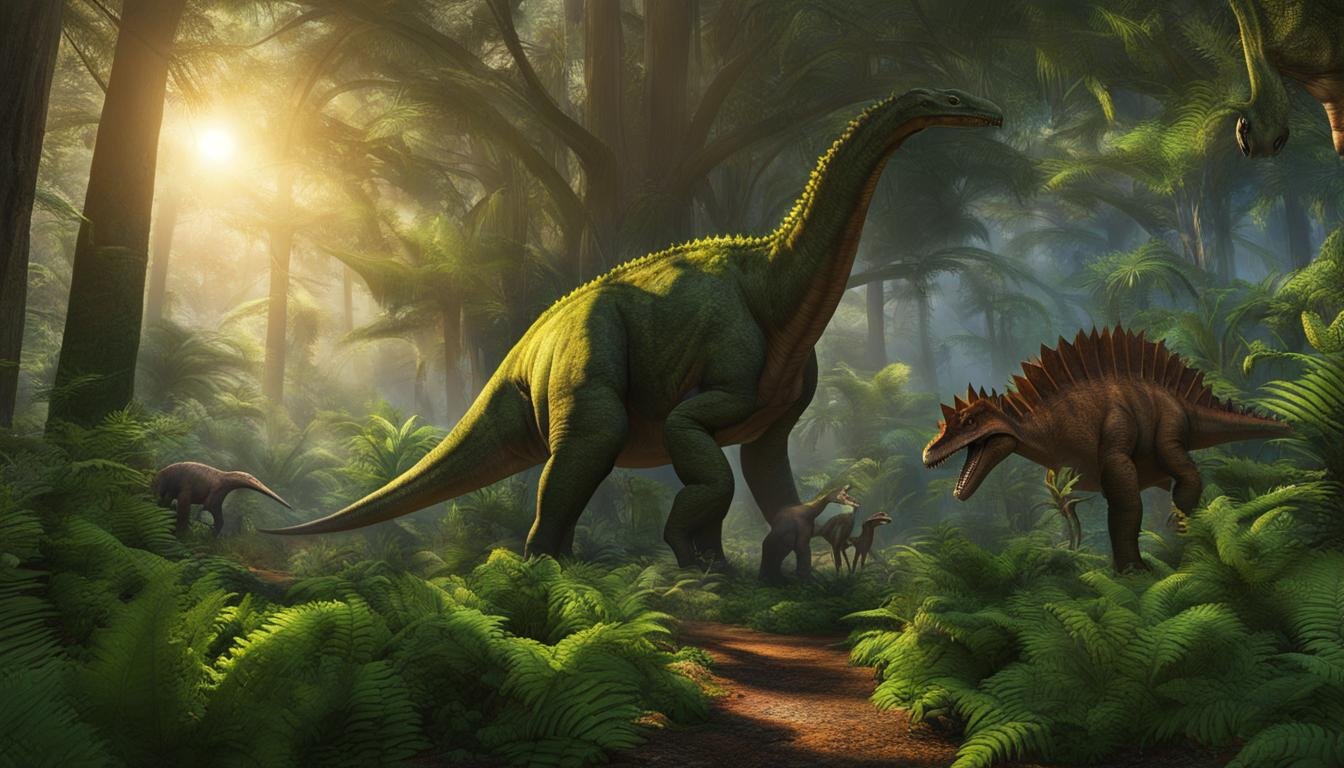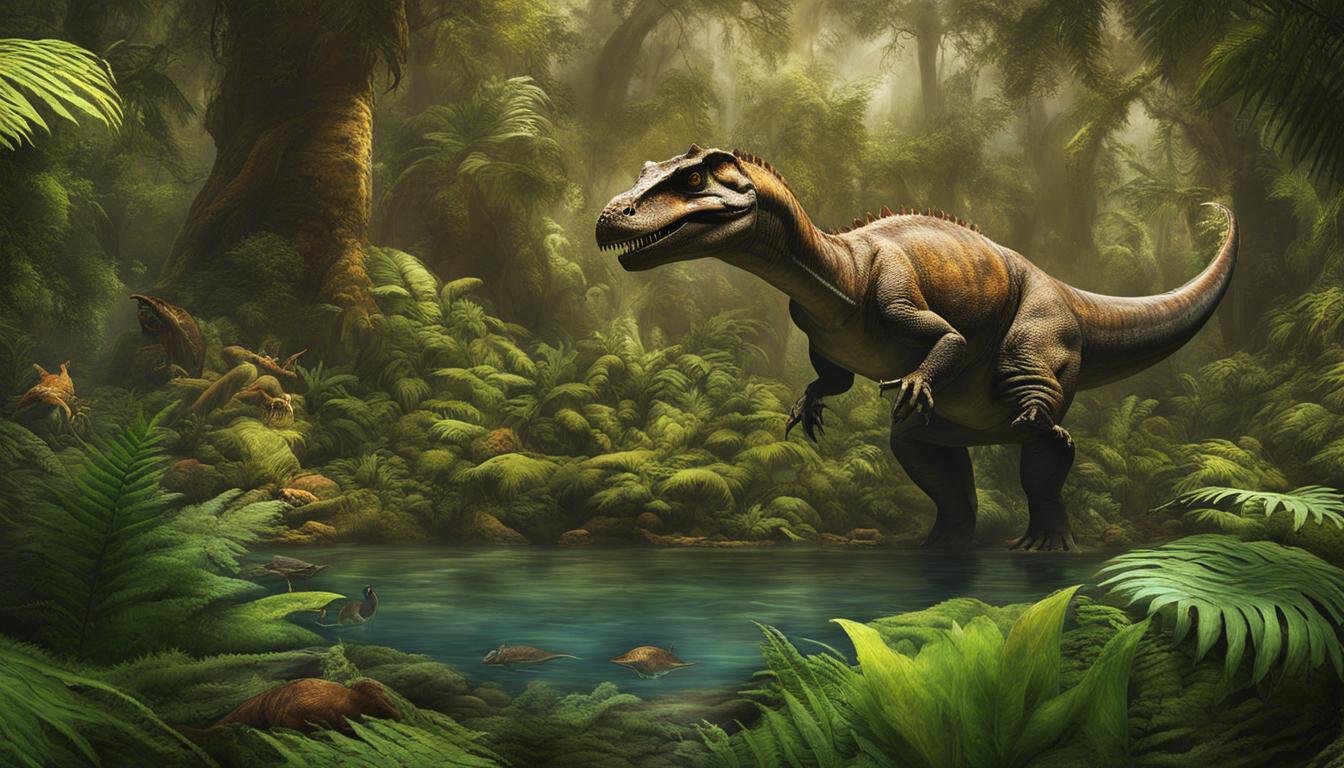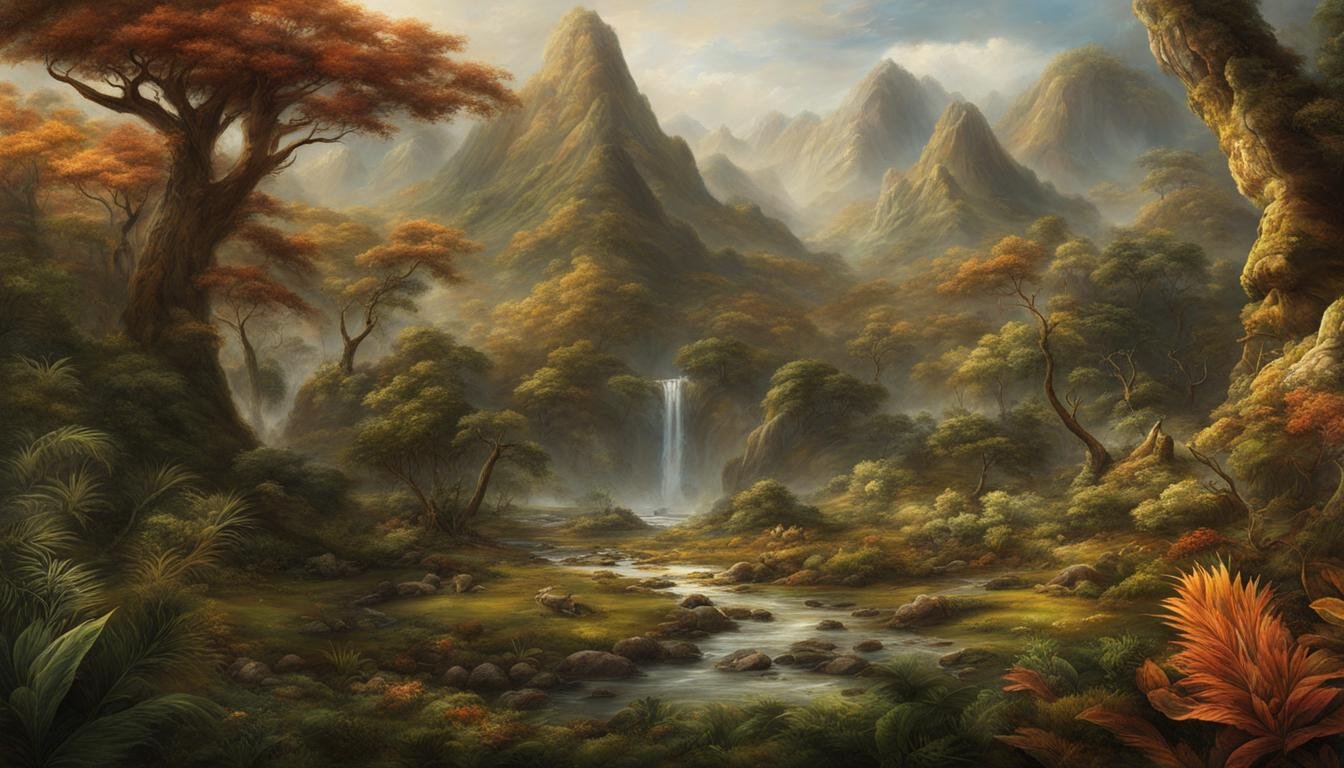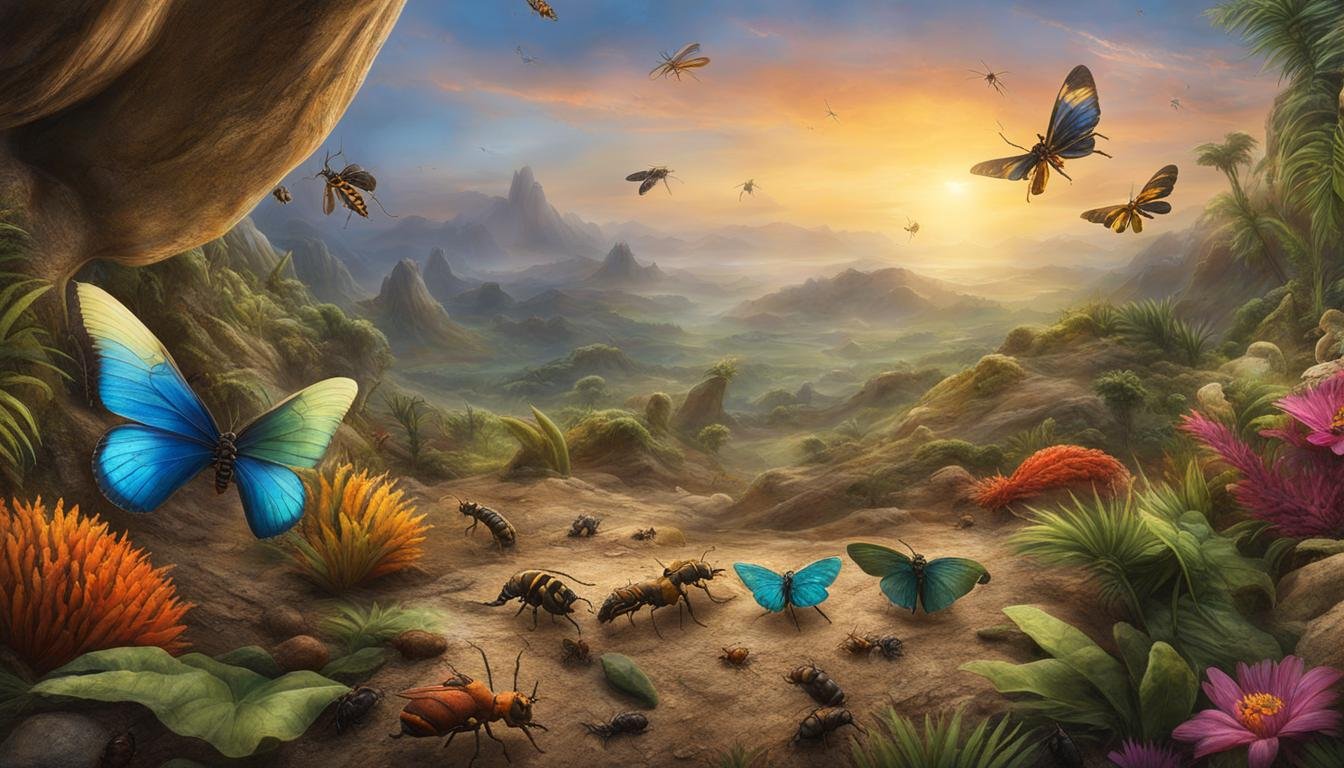Step into the prehistoric world and explore the fascinating connection between forest ecosystems and the dinosaurs that once roamed them. From towering plant-eaters to fearsome carnivores, these ancient forests were teeming with life and provided a vital habitat for a diverse range of prehistoric creatures.
During the Mesozoic Era, dinosaurs inhabited various ecosystems, including lush jungles, dry deserts, and even coastal wetlands. These habitats, similar to modern forests, shaped the behavior and adaptations of these magnificent creatures, allowing them to thrive in their respective environments.
| Key Takeaways | Description |
|---|---|
| Dinosaur Diversity in Forests | Forest ecosystems during the Mesozoic Era supported a diverse array of dinosaur species. |
| Variety of Dinosaur Habitats | Dinosaurs thrived in numerous environments, from lush jungles to dry deserts and coastal wetlands. |
| Ecosystem Influence on Dinosaurs | The different ecosystems dinosaurs inhabited influenced their behavior and evolutionary adaptations. |
| Paleontological Studies of Forest Ecosystems | Ongoing studies and fossil analyses reveal new information about the forest ecosystems where dinosaurs lived. |
| Unraveling Ecological Balance | Scientific discoveries are shedding light on the complex ecological balance of the prehistoric world. |
Common Ecosystems of Dinosaurs
The Mesozoic Era, spanning from 250 to 65 million years ago, was a time of diverse dinosaur habitats. These ecosystems ranged from lush and green equatorial jungles to harsh and arid deserts. Coastal wetlands and riparian forests also provided unique environments for dinosaur species to thrive. Understanding these different ecosystems is crucial for piecing together the complex world of prehistoric creatures.
The Mesozoic Era
The Mesozoic Era, often referred to as the “Age of Dinosaurs,” was a time of significant geological and biological changes. It was divided into three periods: the Triassic, Jurassic, and Cretaceous. Each period had its own distinct ecosystems and plant and animal species. During this era, dinosaurs evolved and adapted to various environmental conditions, resulting in a wide range of habitats.
Lush Jungles
Lush jungles with dense vegetation were a common ecosystem during the Mesozoic Era. These vibrant forested areas provided ample food and shelter for plant-eating dinosaurs like ceratopsians and hadrosaurs. The dense canopies of trees offered protection from predators and provided a diverse range of plant life for herbivores to graze on.
| Jurassic Lush Jungle | Cretaceous Lush Jungle |
|---|---|
| Ferns | Palm Trees |
| Cycads | Conifers |
| Diplodocus | Parasaurolophus |
Table: Comparison of plant and dinosaur species in Jurassic and Cretaceous lush jungles.
Dry Deserts
On the opposite end of the spectrum, dry and arid deserts were also home to dinosaurs during the Mesozoic Era. These harsh environments presented unique challenges, but some dinosaurs, like the famous Velociraptor, were well adapted to survive in these conditions. The Gobi Desert in central Asia was one of the notable desert habitats, hosting a variety of dinosaur species.
“The Gobi Desert was a challenging environment for dinosaurs, with limited water and resources. However, the discovery of well-preserved fossils in this desert has provided valuable insights into the adaptations and behaviors of these prehistoric creatures.”
| Desert Dinosaur | Adaptations |
|---|---|
| Protoceratops | Beady eyes for spotting predators |
| Oviraptor | Long legs for fast movement |
| Velociraptor | Sharp claws for hunting prey |
The Mesozoic Era was a time of incredible diversity in dinosaur habitats. From lush jungles to dry deserts, these ecosystems shaped the behavior and adaptations of these prehistoric giants. By studying the fossil record and analyzing the unique characteristics of each habitat, scientists continue to unlock the secrets of dinosaur ecosystems and gain a deeper understanding of the Mesozoic Era.
Forest-Dwelling Dinosaurs in the Morrison Formation
Located in late Jurassic North America, the Morrison Formation is known for its rich fossil bed that provides valuable insights into the forest-dwelling dinosaurs of the Mesozoic Era. This region was home to a diverse range of dinosaur species, including sauropods, ornithopods, and theropods. These dinosaurs thrived in the lush trees and vegetation that grew alongside rivers and marshes, creating a unique forest ecosystem.
The Morrison Formation is particularly famous for its sauropods, such as Diplodocus, which were gigantic, long-necked herbivores. These gentle giants dominated the forest canopy, reaching lengths of up to 90 feet and weighing as much as 50 tons. Ornithopods, which were bipedal plant-eaters, also roamed the forests of the Morrison Formation. Fossil evidence suggests that these dinosaurs traveled in herds, similar to modern-day grazing animals.
Among the forest-dwelling theropods of the Morrison Formation, Allosaurus was one of the most formidable predators. With its sharp teeth and powerful jaws, this carnivorous dinosaur ruled the prehistoric forest. The ecosystem of the Morrison Formation provided ample prey for these predators, ensuring a balance between herbivores and carnivores.
Dinosaur Species in the Morrison Formation
| Dinosaur Species | Category |
|---|---|
| Diplodocus | Sauropod |
| Stegosaurus | Thyreophoran |
| Camptosaurus | Ornithopod |
| Allosaurus | Theropod |
These diverse forest-dwelling dinosaurs coexisted in the Morrison Formation, forming a complex ecosystem that thrived for millions of years. The fossil record from this region continues to provide valuable information about the unique adaptations and interactions of these prehistoric creatures, shedding light on the ecology of ancient forest ecosystems.
Swamp Forests and Wetlands
The late Cretaceous period saw the emergence of swamp forests and wetlands, unique ecosystems that played a significant role in the lives of dinosaurs. These habitats were characterized by flooded low-lying plains, creating a lush environment that supported diverse plant and animal species.
One prominent feature of swamp forests was the presence of late-evolving plants, including flowers and other flowering plants. These plants served as a vital food source for the herbivorous dinosaurs that inhabited these areas, particularly the large herds of duck-billed dinosaurs, or hadrosaurs. These dinosaurs had specialized teeth that allowed them to efficiently process tough vegetation, enabling them to thrive in the swampy environment.
However, the swamp forests were not without danger. Aquatic predators lurked in the waters, preying on the herbivorous dinosaurs. Among these carnivorous dinosaurs were the formidable Troodon and even the infamous Tyrannosaurus Rex. These predators were well-adapted to the aquatic environment, using their powerful jaws and sharp teeth to capture and consume their prey.
| Ducks-billed Dinosaurs in Swamp Forests | Aquatic Predators in Wetlands |
|---|---|
| Hadrosaurs | Troodon |
| Parasaurolophus | Spinosaurus |
| Edmontosaurus | Suchomimus |
These swamp forests and wetlands left a rich fossil record, providing valuable insights into the prehistoric world. The discovery and study of dinosaur specimens from these environments have allowed paleontologists to piece together the complex interactions and dynamics of these unique ecosystems during the late Cretaceous period.
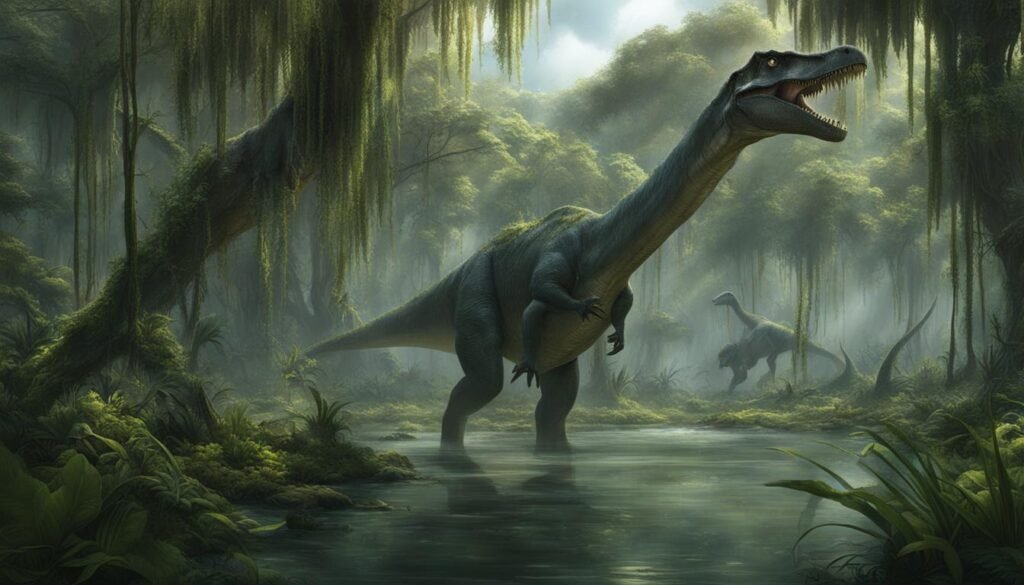
Diverse Plant and Animal Species in Swamp Forests
The swamp forests and wetlands of the late Cretaceous period were teeming with diverse plant and animal species. Apart from the herbivorous hadrosaurs, there were other dinosaurs that called these environments home. Some examples include the armored dinosaurs like Ankylosaurus and the long-necked sauropods such as Apatosaurus. These dinosaurs relied on the abundant plant life in the swamp forests for sustenance.
The presence of flowers in these environments also attracted other types of organisms. In addition to dinosaurs, the ecosystem was populated by various types of insects, birds, and small mammals. The diversity of plant and animal life in the swamp forests created a complex web of interactions and dependencies, showcasing the intricacies of these prehistoric ecosystems.
“The swamp forests and wetlands of the late Cretaceous period were biodiversity hotspots, supporting a wide range of organisms. The lush vegetation and abundant water sources provided the perfect conditions for life to flourish.” – Dr. Sarah Johnson, Paleontologist
The Importance of Wetlands in the Late Cretaceous
Wetlands played a crucial role in the late Cretaceous period, both as habitats for dinosaurs and as contributors to the overall ecological balance. These flooded low-lying plains served as breeding grounds for various aquatic species, including fish, turtles, and crocodiles. They also acted as a natural reservoir, retaining water during periods of heavy rainfall and releasing it slowly during drier times.
In addition to their ecological significance, wetlands played a vital role in preserving dinosaur fossils. The unique conditions in these environments, characterized by waterlogging and sediment deposition, facilitated the preservation of dinosaur remains. As a result, paleontologists have been able to uncover a wealth of information about the dinosaurs that once thrived in these wetland ecosystems, shedding light on their behaviors, adaptations, and interactions with other organisms.
- The swamp forests and wetlands of the late Cretaceous were home to a diverse range of plant and animal species.
- Hadrosaurs, such as Parasaurolophus and Edmontosaurus, were common herbivorous dinosaurs in these environments.
- Aquatic predators like Troodon and Spinosaurus preyed on the herbivorous dinosaurs in the wetlands.
- Wetlands played an essential role in the overall ecological balance of the late Cretaceous period.
- The unique conditions in wetlands facilitated the preservation of dinosaur fossils, providing valuable insights into the prehistoric world.
Deserts and Arid Environments
Deserts played a challenging role in the lives of dinosaurs, presenting harsh conditions and limited resources. One notable desert of the Mesozoic Era was the Gobi Desert, located in central Asia. This arid environment was home to a variety of dinosaur species, including the famous Protoceratops, Oviraptor, and Velociraptor.
Protoceratops is known for its distinctive frilled head and beak-like mouth, while Oviraptor had a unique crest on its head and is believed to have been an egg thief. Velociraptor, on the other hand, was a swift and intelligent predator with sharp claws.
| Dinosaur | Description |
|---|---|
| Protoceratops | A herbivorous dinosaur with a frilled head and a beak-like mouth. |
| Oviraptor | A dinosaur with a crest on its head, believed to have been an egg thief. |
| Velociraptor | A swift and intelligent predator with sharp claws. |
Fossils of these dinosaurs have been found in entwined positions, suggesting interactions and struggles in the desert environment. Despite the harsh conditions, these fascinating creatures adapted to survive and thrive in the arid landscapes.
Interestingly, the Sahara, which is now the world’s largest desert, was once a lush jungle during the age of dinosaurs. This demonstrates the ever-changing nature of environments over millions of years, creating diverse habitats for different species to evolve and adapt.
Did You Know?
“Deserts were not obstacles to dinosaurs, but rather unique environments that shaped their behavior and adaptations.” – Dr. Alan Grant, Paleontologist
Deserts are not simply barren wastelands, but rather complex ecosystems that have played a significant role in the evolution and diversity of life on Earth, including the dinosaurs that once roamed these arid landscapes.
Lagoons and Aquatic Environments
Lagoons played a significant role in the diverse ecosystems of the Mesozoic Era. These large bodies of calm water, trapped behind reefs, were home to a variety of prehistoric creatures. One notable lagoon is Solnhofen in Germany, which has yielded numerous fossils of dinosaurs and pterosaurs, providing valuable insights into the ancient aquatic environment.
Within the Solnhofen lagoon, fossils of dinosaurs like Archaeopteryx and Compsognathus have been discovered. Archaeopteryx, often referred to as the “first bird,” possessed a unique combination of bird and reptile characteristics. Its fossilized remains have helped scientists understand the evolutionary link between dinosaurs and birds.
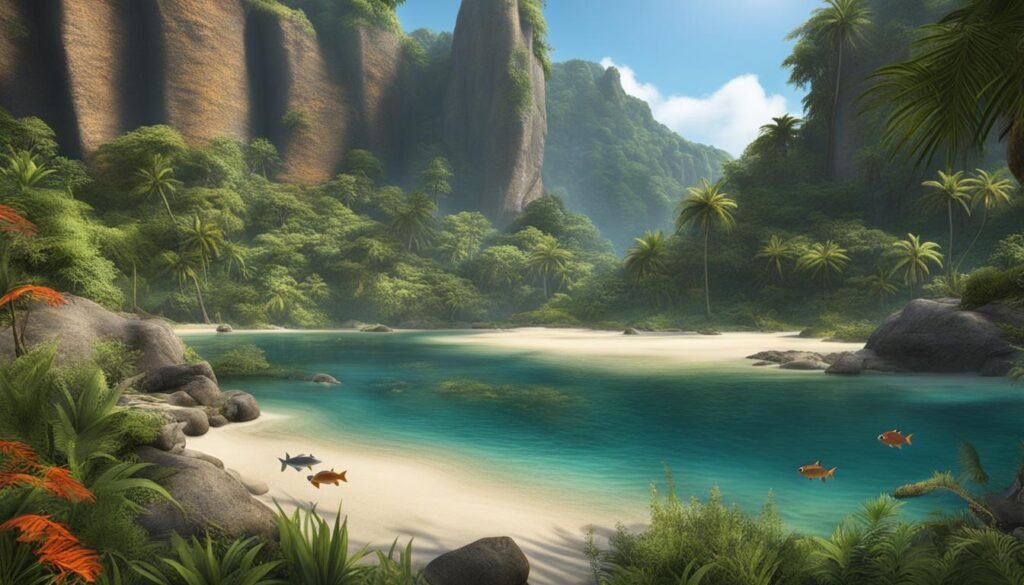
Compsognathus, on the other hand, was a small carnivorous dinosaur that likely inhabited the lagoon’s shoreline. With its lightweight body and agility, Compsognathus was well adapted to hunting in this aquatic environment.
| Dinosaur | Description |
|---|---|
| Archaeopteryx | Ancient bird-dinosaur hybrid |
| Compsognathus | Small, agile carnivorous dinosaur |
| Pterosaurs | Flying reptiles adapted to the lagoon environment |
Pterosaurs, another group of prehistoric reptiles, also thrived in lagoon environments. These flying creatures, known for their wingspans and unique adaptations for flight, utilized the lagoons as a source of food and shelter.
The fossils found in lagoons provide valuable evidence of the diverse life forms that inhabited these Mesozoic ecosystems. From ancient birds to small carnivorous dinosaurs and flying reptiles, the Solnhofen lagoon offers a window into the fascinating world of prehistoric lagoon environments.
Polar Environments
During the Mesozoic Era, the polar regions were not as cold as they are today, but they still presented unique challenges for dinosaur inhabitants. Australian dinosaurs, in particular, had to adapt to the polar conditions. One such dinosaur is Leaellynasaura, a small herbivorous dinosaur that lived in what is now Victoria, Australia. Leaellynasaura had large eyes, which suggests that it was adapted to navigate in low light conditions caused by the long periods of darkness in the polar regions.
“Leaellynasaura’s large eyes indicate its ability to adapt to the polar environment with limited sunlight. This adaptation allowed it to forage for food and navigate effectively, despite the challenging conditions,” says Dr. Jane Patterson, a paleontologist at the University of Victoria.
Another dinosaur that thrived in the polar environments was Minmi, a heavily armored dinosaur that lived in what is now Queensland, Australia. Minmi likely had slow metabolic rates and may have been cold-blooded, allowing it to survive the cold temperatures of the polar regions. Its unique adaptations, such as its armor plates and spines, offered protection from predators and helped it regulate body temperature.
Intriguingly, evidence suggests that Spinosaurus, a large carnivorous dinosaur, had adaptations to a polar environment, indicating that it may have been semiaquatic or even fully aquatic. The polar regions likely provided an abundant food source for Spinosaurus, as marine life such as fish and marine reptiles would have migrated to the region during the warmer months.
Polar Dinosaur Overview
| Dinosaur | Location | Adaptations |
|---|---|---|
| Leaellynasaura | Victoria, Australia | Large eyes for low light navigation |
| Minmi | Queensland, Australia | Armor plates and spines for protection |
| Spinosaurus | Various regions | Potential semiaquatic or fully aquatic adaptations |
The polar environments of the Mesozoic Era provide fascinating insights into the ability of dinosaurs to adapt to extreme conditions. Through the study of fossils and paleontological research, scientists continue to uncover the secrets of Australian dinosaurs like Leaellynasaura, Minmi, and the enigmatic Spinosaurus, shedding light on the remarkable diversity and adaptability of these prehistoric creatures.
Conclusion
As we delve into the wonders of the Mesozoic Era, we discover a world teeming with prehistoric giants that roamed the Jurassic landscape. These majestic creatures inhabited a variety of ecosystems, each with its own unique characteristics and challenges. Through the careful study of dinosaur fossil records, scientists are piecing together the puzzle of these ancient forest environments.
These forest ecosystems were home to a diverse array of dinosaur species, from towering sauropods and agile ornithopods to formidable theropods. The lush trees and vegetation provided ample food and shelter for these magnificent creatures, fostering a delicate ecological balance. As we continue to unearth the secrets of these ancient habitats, we gain a deeper understanding of the intricate web of life that once existed.
The study of prehistoric ecosystems not only reveals the lives of the dinosaurs that once roamed the Earth but also provides valuable insights into our own world today. By examining the behaviors and adaptations of these ancient creatures, we gain a greater appreciation for the importance of biodiversity and the delicate harmony that sustains life on our planet. The Jurassic landscape serves as a reminder of the incredible adaptability and resilience of Earth’s inhabitants throughout time.
Through ongoing research and exploration, we continue to unlock the mysteries of the past and bring these prehistoric giants to life. The study of forest ecosystems and their dinosaur inhabitants is an ongoing journey, one that fuels our curiosity and deepens our understanding of the remarkable world we live in.

